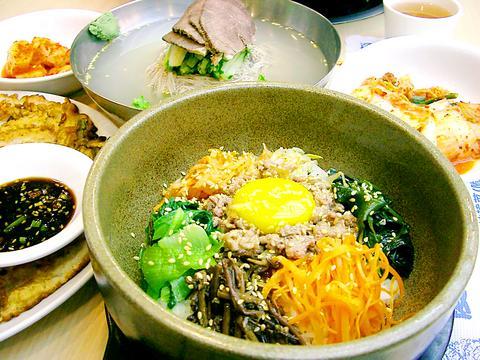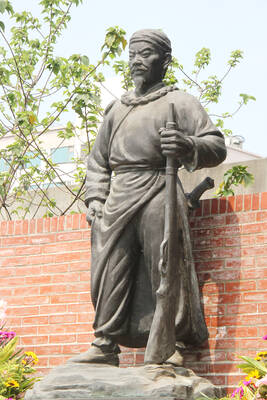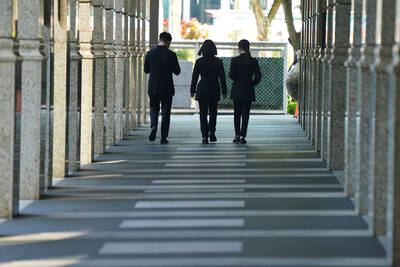Thanks to the popularity of South Korean TV dramas and pop stars, more South Korean restaurants are emerging on Taipei's gourmet map. But among all those trendy barbecue places it is not easy to find an authentic Korean restaurant. Kyung-ju House is among the few.
It is the place to enjoy the authentic Bi-bim Pap, or stone bowl mix rice, and the famous Korean-style cold noodles. According to owner Yin Tsai-lien (

PHOTO: YU SEN-LUN, TAIPEI TIMES
Traditionally in Korean families the wife used to eat the left-over food after everyone else had finished their dinners. She got to mix the vegetables and a little meat in a rice bowl made of stone and heat it it by the fire. Bi-bim Pap nowadays is more sophisticated.
Yin first spreads sesame oil at the bottom of the stone bowl, then adds cooked rice, followed by bean sprouts, seaweed, carrot and beef on top. When the stone bowl is grilled and the rice at the bottom gets a bit crispy, she then puts an egg yolk on top, and finishes the dish.
As for cold noodles, there are two choices. The dry, cold noodles are a good choice for those seeking hot and strong tastes. The dish is red because the sauce is extracted from Korean chili powders, mixed with shredded vegetables, including onions, carrots and cucumbers. The Korean buckwheat noodles are thin, but chewy enough to test your teeth. When being served, the waiter comes and cuts the noodles in three parts with scissors so that you can eat.
The cold soup noodle dish really is cold. The stock is stewed with beef bones, onions, carrots and radishes for a whole day, and then refrigerated.
Yin Tsai-lien and her husband Chang Li-kuo (
"From kitchen utensils to food ingredients, we import largely from Korea," said manager Chang Ching-li (

JUNE 30 to JULY 6 After being routed by the Japanese in the bloody battle of Baguashan (八卦山), Hsu Hsiang (徐驤) and a handful of surviving Hakka fighters sped toward Tainan. There, he would meet with Liu Yung-fu (劉永福), leader of the Black Flag Army who had assumed control of the resisting Republic of Formosa after its president and vice-president fled to China. Hsu, who had been fighting non-stop for over two months from Taoyuan to Changhua, was reportedly injured and exhausted. As the story goes, Liu advised that Hsu take shelter in China to recover and regroup, but Hsu steadfastly

Taiwan’s politics is mystifying to many foreign observers. Gosh, that is strange, considering just how logical and straightforward it all is. Let us take a step back and review. Thanks to the Chinese Nationalist Party (KMT) and the Taiwan People’s Party (TPP), starting this year people will once again have Christmas Day off work. In 2002, the Scrooges in the Democratic Progressive Party (DPP) said “bah, humbug” to that. The holiday is not actually Christmas, but rather Constitution Day, celebrating the enactment of the Constitution of the Republic of China (ROC) on December 25, 1947. The DPP and the then pan-blue dominated legislature

Focus Taiwan reported last week that government figures showed unemployment in Taiwan is at historic lows: “The local unemployment rate fell 0.02 percentage points from a month earlier to 3.30 percent in May, the lowest level for the month in 25 years.” Historical lows in joblessness occurred earlier this year as well. The context? Labor shortages. The National Development Council (NDC) expects that Taiwan will be short 400,000 workers by 2030, now just five years away. The depth of the labor crisis is masked by the hundreds of thousands of migrant workers which the economy absolutely depends on, and the

If you’ve lately been feeling that the “Jurassic Park” franchise has jumped an even more ancient creature — the shark — hold off any thoughts of extinction. Judging from the latest entry, there’s still life in this old dino series. Jurassic World Rebirth captures the awe and majesty of the overgrown lizards that’s been lacking for so many of the movies, which became just an endless cat-and-mouse in the dark between scared humans against T-Rexes or raptors. Jurassic World Rebirth lets in the daylight. Credit goes to screenwriter David Koepp, who penned the original Jurassic Park, and director Gareth Edwards, who knows